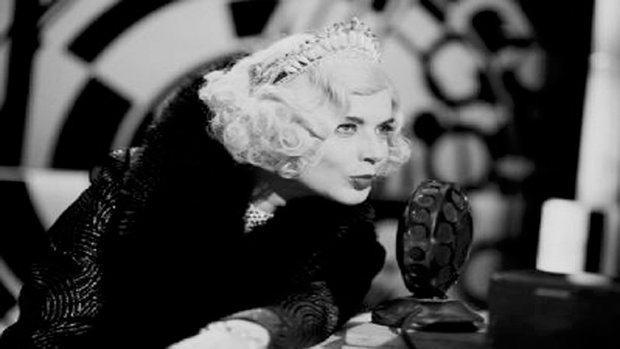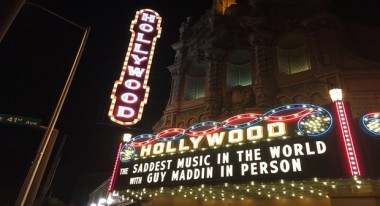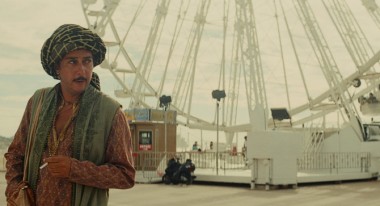 Back to selection
Back to selection
Guy Maddin on The Saddest Music in The World and His Interactive Seances
 Isabella Rossellini in The Saddest Music in the World
Isabella Rossellini in The Saddest Music in the World It only seemed fitting that Portland-based folk musician Michael Hurley would perform a short set of sad songs before the screening of Guy Maddin’s 2003 experimental melodrama The Saddest Music in the World on Friday, March 25 at the Hollywood Theatre in Portland.
Maddin himself was in attendance for the sold-out screening, which was presented as part of the Hollywood’s Mississippi Records Music & Film Series.
 In introducing the film, Maddin said it was a treat to “show this movie I barely remember making. I think what I recall is the movie is about a sad song contest, so Michael [Hurley], I noticed, played a lot of deliciously sad songs.”
In introducing the film, Maddin said it was a treat to “show this movie I barely remember making. I think what I recall is the movie is about a sad song contest, so Michael [Hurley], I noticed, played a lot of deliciously sad songs.”
Set in Maddin’s home town of Winnipeg during the Great Depression, the film tells the mythic story of Helen Port-Huntley, a double amputee beer baroness (Isabella Rossellini) who holds an international contest to see which country can produce the saddest song in the world.
After the film, Maddin got philosophical saying, “I was just looking at the end credits and seeing the names of people I haven’t seen in so long. I just realized that as a filmmaker you have the end credits of your life rolling.” As for the people who worked on The Saddest Music, Maddin drolly confessed, “I don’t where they all went. I hope they’re okay.”
In a conversation with Eric Isaacson of Mississippi Records, Maddin talked about his inspiration for the film, his latest project, and his thoughts on the future of cinema. Below are some highlights:
On landing Isabella Rossellini for the part of Baroness Helen Port-Huntley
 My screenwriting collaborator back then — George Toles, my old screenwriting professor — decided to write a part for Isabella Rossellini because we never really had movie stars before. Isabella hadn’t acted in a number of years, so she wasn’t a big movie star, but she was in some movies that we loved.
My screenwriting collaborator back then — George Toles, my old screenwriting professor — decided to write a part for Isabella Rossellini because we never really had movie stars before. Isabella hadn’t acted in a number of years, so she wasn’t a big movie star, but she was in some movies that we loved.
She’d always shown a lot adventurousness. She seemed willing to work for schmucks like me so it seemed almost plausible that she would work with me. We wrote the part with her in mind, so it was nice to hear her say in that Scanda-Italian accent of hers — or whatever that is — all those lines, just the way they were written down.
Getting her was another matter. Her agent really wanted to blow us off. It was the biggest fluke in the world. I had been in New York and I was hoping, but I knew I was too chicken to make a cold call with her agent. I was walking through Central Park and actually saw Isabella Rossellini.
I could say “Isabella, I’ve got this script for you,” but what a dweeb move. I know the way I am. I am too shy and sensibly so, because what do you do with a celebrity? You leave them alone. But she suddenly stopped to pet a big labrador retriever and I thought “Well, I can stop and pet this labrador retriever.” I like labrador retrievers as much as anyone else. So I just started petting this labrador retriever while she was talking to its owner.
And she was really comfortable with dogs. She had her hand in its mouth down its throat. Its tongue had wrapped itself around her fingers a number of times. Pretty soon I just put my hand in there too. It was so slippery and warm in there. I couldn’t even tell what was her fingers and what was the dog. I was sort of looking into her eyes and before we knew it, the dog and its owner were gone and she and I were just sitting there with our slobbery fingers interlocked. I said, “Isabella Rossellini, I’ve got a script for you.” We went back to her place and watched some movies and now she’s in the movie.
On casting Maria de Medeiros as a mysterious nymphomaniac amnesiac

I felt like I was on a roll and I really wanted Maria de Medeiras too. She seems to have walked out of a time machine. My producer Jody Shapiro is Portugese and so is Maria, so that means he had her number. I was so full of confidence but there was no dog involved. She said “OK.”
The thing with Maria de Madeiras was, she said, “I hear it’s very cold in Canada.” I said, “Yeah, it is.” Winnipeg is the coldest city in the world, as far as I know. But I assured her that Winnipegers overheat their homes, they overheat their stores. When you walk in the door of a department store, you practically faint from the heat, especially the contrast when the temperature outside is minus 40 and it’s 95 degrees Fahrenheit inside the store. I assured her it would be practically tropical. And then after she agreed to come I found out that the studio that we had rented — which is this old iron factory — was not insulated. And it was the coldest winter in Winnipeg. We had a nude scene she was all excited about doing but her Portuguese blood was not up for it.
At one point, I said, “I’m so sorry it’s colder than I led you to believe.” And she said, “Of all the directors I’ve had” — and I’ve looked at her IMDB page and she’s had about 90 — she said, “You have lied to me the most.” But her mood, you can adjust her mood like you can adjust your thermostat. When the movie premiered at the Venice Film Festival and it was 92 with a humidex of 110 or something, she was so happy to see me. I feel like directing her with a heater.
On finding the international musicians for the film
The movie’s budget is low and Winnepeg is not a culturally diverse city; it’s more so now, it’s been years since the film was made. But it’s the kind of city where Immigration Canada now sends new Canadians to serve penance.
But there are little clumps of women’s Scottish bag pipers, say, or Portuguese fado, there was a very small little pocket of Greek musicians. I just held an open audition, but the movie was so low budget, the audition notice said “must bring own costume” because I knew we couldn’t afford any. And we rented a cheap boardroom on the 7th floor of some hotel and I remember just sitting there, just looking at showgirls, but it was musicians.
There would be a klezmer band. After a while I got bored of asking the klezmer bands to play a sad song so I asked them to stick around while the fado band and have the play off each other. I do remember sitting at the table and hearing something droning, like an air raid siren getting louder and louder. What it was was the all-female bagpipers — a murder, is that what they’re called? They were just rising in the elevator, but they were playing so they were getting closer. The 2nd floor, the 3rd floor, then the elevators doors open and it’s like ROAR and one of them had box of Tim Hortons donuts and they’re squeezing that old bag under the armpit. And then they played for a while and then they just turned around, kept playing and went into the elevator and disappeared. I had to hire them.
On the conceptualization of the film
It was the first time I made movie that wasn’t completely generated from my own obsessions, but I turned someone else’s ideas into something that I could get excited about. The British author Kazuo Ishiguro wrote a script before he had written any novels back in the early ’80s. He had written this script — it kicked around a lot. I could tell. My producer on a short movie I made in 2000, Niv Fichman, gave me the script. He said “I’ve got this script by Kazuo Ishiguro,” but I could tell that Atom Egoyan’s fingerprints were all over it. He had looked at it for a while and then thought “nah, no.” [Egoyan served as the executive producer on the film].
I was kind of down on it. It was set in London and in the present day, which was 1983, but its premise was very strong: that there was this contest co-sponsored by a CNN-like news thing and a distillery that would reward countries for singing the saddest song.
It’s kind of the way — we all know unfortunates. We see them all the time, homeless people who are less lucky than we are. They not only are unfortunate, but then they have to put on a performance on top of it to sell their unfortunate sadness. I’m sure that makes everyone uncomfortable. The idea that you have to market your unfortunate position — it just struck me that this happens at a personal level and also on a macrocosmic level with nations.
There’s only so much audience in the world — we all know from the news — especially since around the time I made this movie. We’re all aware of the news cycle and how much sympathy you can get. But it’s always been this way, ever since Randolph Hearst. That you’ve got to make someone’s plight sexy for a while so that anyone can empathize with it in a way to sell advertising.
What hooked it for me was setting it in Winnipeg and setting it in a time I was more comfortable with then. Now I’m a little bit more comfortable with the present. And setting it in the Great Depression, just the word depression is sad. And Prohibition in America — there wasn’t Prohibition in Canada, but a lot of Canadians got wealthy selling alcohol to Americans. So all the sudden, it started to sink in that I could mythologize my home town of Winnipeg in emulsion. which is a great medium for mythologization.
On his latest project, Seances, which will premiere on April 14 online and as part of The Tribeca Film Festival’s Storyscapes

I shot in public at the Centre Pompidou for three weeks in Paris and at a place called the Phi Centre in Montreal for another three weeks. One film per day, a short film about 15-20 minutes each. Each one is an adaptation of a lost movie that once existed.
Alfred Hitchcock, you can’t see his complete works because The Mountain Eagle, one of his films, was lost. No one knows where it is and the negative is long gone, turned into dust or burst into flames. There are so many other masterpieces — even Academy Award-nominated, not that that means anything — films lost.
I thought the only way I’d ever be able to see these movies was if I make them myself. So I shot my own adaptations of them and then with partners (Evan Johnson and Galen Johnson), it evolved into this interactive projected hosted by the National Film Board of Canada. I’m really excited about it.
The films are fragmented and you go online and you hold a seance with lost cinema. And these spirits of these films in fragmentary forms come at you and they interrupt each other. If a signal from one lost film interrupts, it forms a of one-of-a-kind non sequitur, a mixture of stories that kind of feel like a beginning, a middle and an end, the way they’re next to each other.
If you go to the website you’ll watch one of these things, you’ll hold a seance for cinema, you’ll watch one of these movies that will be somewhere between 5 and 15 minutes long — most people will stop to check their e-mail — and then once the movie is over, the interactive destroys that movie so it will never be seen again.
So it produces out of lost matter a new movie to live just once, like a fruit fly and then it’s destroyed instantly again. I’m hoping that every once and again the non sequiturs add up just right and it’s pleasing and the viewer is in just the right mindset for it so that once the movie is destroyed there will be a natural sense of loss. If no one does anything else than try the title generator, people will just be able to read a long list — I hope people come and it’s a long list — of titles that were produced and destroyed.
On the future of cinema
I’m really excited about where cinema is right now. I really like the fact that people quit worrying about whether documentaries are true or not. And that they realize that once you commit a fact to a piece of paper it becomes a piece of fiction. I love the fact that movie audiences understand that now inherently and that there’s so much potential in the cine-essay. You can literally put a dramatic narrative film in the middle of — or shuffle it in — a cine-essay an have a documentary at the end. There are so many hybrids possible.

It seems that cinema is just beginning. Miguel Gomes’s Arabian Nights and all six hours of it or however long it is — it is a really nice blend of cultural criticism and fictional devices. There are so many places you can go with cinema and I’m really excited about it. My next film will probably be a fictional feature, but I hope to make lots of cine-essays or documentaries, whatever that means anymore. I’m just excited about the potential to be mischievous and hopefully a little smarter with each passing year. That’s my little state-of-the union optimistic shpritz.
